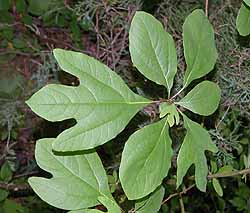 Sassafras
SassafrasSassafras Albidum
Common Names
Sassafras, ague tree, cinnamon wood, common sassafras,
red sassafrass, saxifras, smelling stick, white sassafras.
Description
Sassafras is a tree that grows to 40 feet in height. Twigs are green
and produce particularly interesting leaves of 3 different shapes:
one that looks like a mitten with 2-lobes, one that has three lobes and one that looks
like a "normal" leaf. All parts of the tree have
a spicy aroma. Fragrant, yellowish-green flowers are
borne in clusters. Male and female flowers are usually borne
on different trees. In September the female flowers develop
into dark blue 1-seeded berries, about pea size, that are
borne on a thick red stalk.
Sassafras roots have been used to make a tea, and the original "root beer" came from this tree.
Flowering Period
March to April
Habitat
Along fence rows; in open woods and abandoned fields, and on
dry ridges.
Harvest
Root bark in spring and autumn; entire root in fall.
Uses
The root bark can be used to prepare a tea. Root material can
be distilled to make sassafras oil, which is used mainly as a
flavoring agent in beverages, confectionery tooth paste, and
the like. The tea has been used as a diaphoretic, stimulant, diuretic,
and carminative; and it is used in Appalacia to treat bronchitis.
The bark is reportedly used also as an insect repellent. Colonial
Americans were advised to chew the bark of this tree to break
the tobacco habit. Sassafras leaves have been used as a dye to make
a soft yellow tan. And some research suggest that, under certain
conditions, the leaves may be carcinogenic.